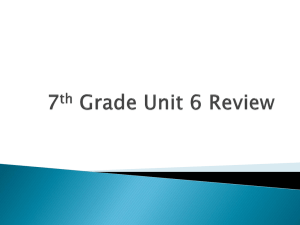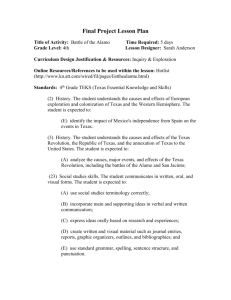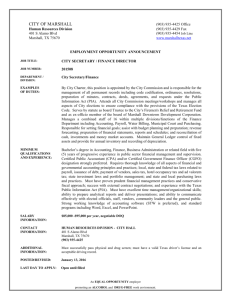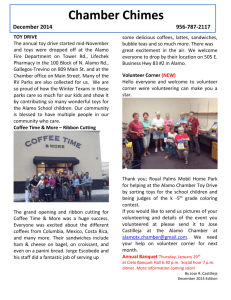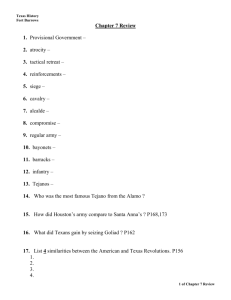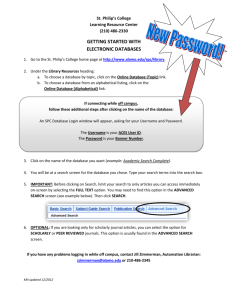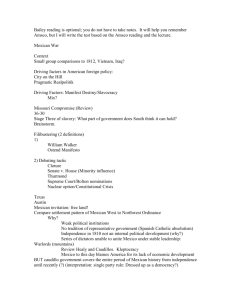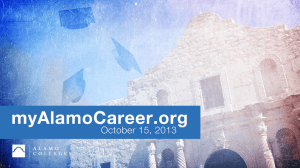Tejanos in the Battle of the Alamo: Building Alternative Perspectives
advertisement
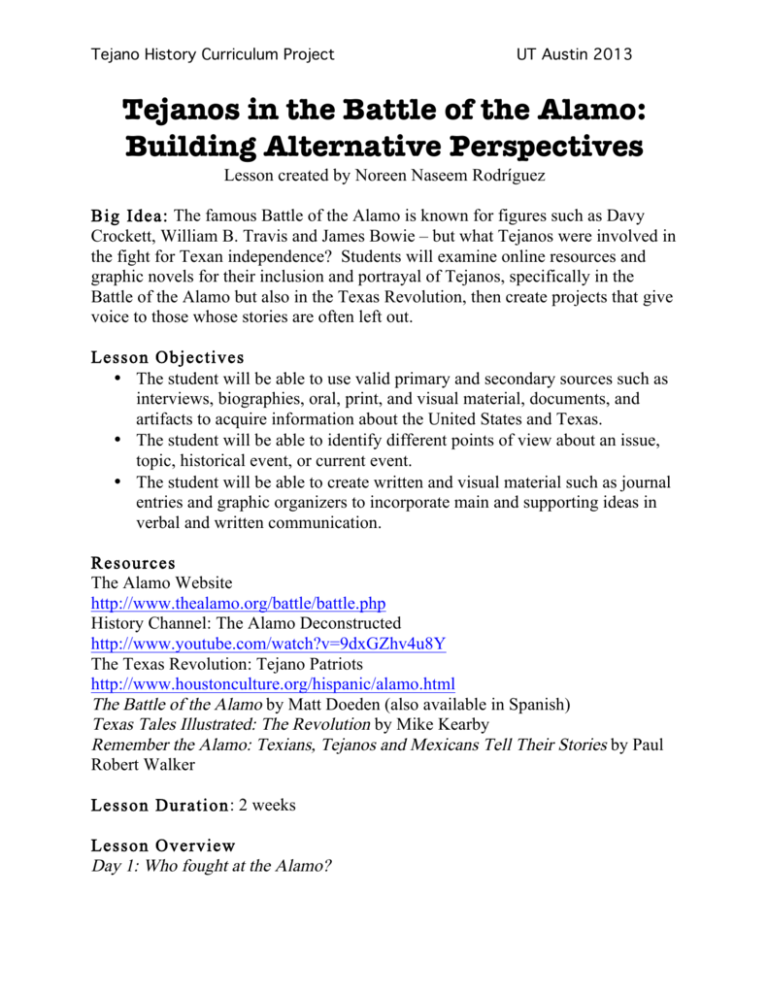
Tejano History Curriculum Project UT Austin 2013 Tejanos in the Battle of the Alamo: Building Alternative Perspectives Lesson created by Noreen Naseem Rodríguez Big Idea: The famous Battle of the Alamo is known for figures such as Davy Crockett, William B. Travis and James Bowie – but what Tejanos were involved in the fight for Texan independence? Students will examine online resources and graphic novels for their inclusion and portrayal of Tejanos, specifically in the Battle of the Alamo but also in the Texas Revolution, then create projects that give voice to those whose stories are often left out. Lesson Objectives • The student will be able to use valid primary and secondary sources such as interviews, biographies, oral, print, and visual material, documents, and artifacts to acquire information about the United States and Texas. • The student will be able to identify different points of view about an issue, topic, historical event, or current event. • The student will be able to create written and visual material such as journal entries and graphic organizers to incorporate main and supporting ideas in verbal and written communication. Resources The Alamo Website http://www.thealamo.org/battle/battle.php History Channel: The Alamo Deconstructed http://www.youtube.com/watch?v=9dxGZhv4u8Y The Texas Revolution: Tejano Patriots http://www.houstonculture.org/hispanic/alamo.html The Battle of the Alamo by Matt Doeden (also available in Spanish) Texas Tales Illustrated: The Revolution by Mike Kearby Remember the Alamo: Texians, Tejanos and Mexicans Tell Their Stories by Paul Robert Walker Lesson Duration: 2 weeks Lesson Overview Day 1: Who fought at the Alamo? Tejano History Curriculum Project UT Austin 2013 1. The teacher should ask students what they already know about the Alamo. Who were the groups fighting against each other? Do they know the names of anyone who fought in the battle? What did those people do? You can record this information in a list, in the “K” section of a KWL chart, or use an idea web or other graphic organizer. 2. Make arrangements for students to have individual or partner access to the internet via laptops, iPads, etc. Direct students to the History Overview of the Alamo website (http://www.thealamo.org/battle/battle.php) and as a group read the overview together and discuss its meaning. 3. Once students have a more detailed understanding of the battle, ask them to click on the left The Defenders tab. With their partners or as individuals, ask students to count the number of names that they think might be Spanish or Mexican in origin. Then have students click on each name and scan the biographical information found at the Handbook of Texas Online that is linked to the the list of names. Allow students time to adjust their count of Tejano defenders, then share out as a class. Then count the total number of defenders. Why do students think there was such a small population of Tejano defenders? 4. Give students the following questions and allow them 10-15 minutes to find as many answers as they can. • How many defenders of the Alamo were Tejanos (born in Texas)? • How many defenders of the Alamo were born in Europe? • Who was allowed to leave the Alamo? • Who was the only defender of the Alamo who was buried? • Who died at the Alamo on his birthday? • Who was born in the Alamo when it was a mission and died in the battle there? • Who was the oldest defender at the Alamo, fighting at the age of 56? • What Alamo defender was famous for his special knife designed by his brother? 5. Davy Crockett arrived in Texas in early January of 1836. He died at the Alamo on March 6, 1836. He, unlike the Tejano defenders, was not a Texas native and had only been in Texas less than three months, yet he is one of the most famous figures of the Battle of the Alamo. Ask students to consider this interesting fact and share their opinions. 6. Use any remaining time to allow students to explore the rest of The Battle section of the Alamo website. Alamo Myths is quite interesting. 7. Extension: The linked article describes more closely the defenders of the Alamo, with special attention to the Tejano defenders http://www.houstonculture.org/hispanic/alamo.html Days 2-4: How is the story of the Alamo told? Tejano History Curriculum Project UT Austin 2013 1. Prepare and pass out copies of the “Considering Perspective in the Battle of the Alamo” reading chart (you may want to put “Who’s Who at the Battle of the Alamo” on the opposite side, or if using a journal, provide a copy to glue onto a facing page). Tell students that each day for three days, they will study a different resource about the Alamo and analyze it in terms of what information it provides, what historical figures are mentioned, and whether or not Tejanos are included in the account. 2. On Day 2, play the History Channel’s “The Alamo Deconstructed” video 23 times for students to analyze. Stop in between showings to talk about what students learned, who was mentioned, and how Tejanos were or were not included. After recording this information on the perspective reading chart, check the Who’s Who list to see if they identified anyone. Because this is the first day using the chart, you may want to guide student responses via a document camera or projector. 3. On Day 3, read the Texas Tales book. Because this text is long, you may want to pause periodically (at least after each page or two) to record what students learn and important historical figures that are mentioned. Use the map in the Alamo reading chart PDF file to show students where the events in the graphic novel took place. Fill out responses to all questions, either guided or independently, then as a class compare and contrast today’s graphic novel to yesterday’s short movie. Add to the Who’s Who list if time permits. 4. On Day 4, read The Battle of the Alamo (also available in Spanish). As you did with Texas Tales, pause periodically to record information/answer questions on the perspective chart. After the chart is completed, finish Who’s Who. Discuss what students have learned about the way the story of the Battle of the Alamo is traditionally told/taught. Days 5-10: Alternative Perspective Projects 1. From the three readings done in class, students should recognize that many people participated in the Battle of the Alamo and Texas Revolution whose stories are not often told. Give each student a copy of the Alternative Perspective Project assignment page, and read the introductory paragraph to the class. 2. The assignment page gives students several options in terms of both project format (story writing/drawing, creating a graphic novel, making glogs/podcasts, or composing a readers theater) and topic. You will need to provide the model text Susanna of the Alamo by John Jakes, printed copies of Time Warp Alamo, and copies of the informational text at the end of Tejano History Curriculum Project UT Austin 2013 Texas Tales that provides information about Panchita Alavez, the Gonzalez mounted rangers and Juan Seguín’s company of Tejano soldiers. 3. Students should work in self-chosen or teacher-selected groups of 2-4 over the course of 3-5 days to research and create their projects. On the final day(s), they should present their work to the class. Lesson Documents Alamo reading chart PDF (with Defenders question sheets, Considering Perspective in the Battle of the Alamo reading chart, Who’s Who in the Battle of the Alamo picture chart, and supplemental map of battles of the Texas Revolution) Alternative Perspective Projects assignment page Time Warp Alamo readers theater Texas Essential Knowledge & Skills (4.3) History. The student understands the importance of the Texas Revolution, the Republic of Texas, and the annexation of Texas to the United States. The student is expected to: (A) analyze the causes, major events, and effects of the Texas Revolution, including the Battle of the Alamo, the Texas Declaration of Independence, the Runaway Scrape, and the Battle of San Jacinto; (B) summarize the significant contributions of individuals such as Texians William B. Travis, James Bowie, David Crockett, George Childress, and Sidney Sherman; Tejanos Juan Antonio Padilla, Carlos Espalier, Juan N. Seguín, Plácido Benavides, and José Francisco Ruiz; Mexicans Antonio López de Santa Anna and Vicente Filisola; and non-combatants Susanna Dickinson and Enrique Esparza; (C) identify leaders important to the founding of Texas as a republic and state, including José Antonio Navarro, Sam Houston, Mirabeau Lamar, and Anson Jones; (4.16) Citizenship. The student understands important customs, symbols, and celebrations of Texas. The student is expected to: (A) explain the meaning of various patriotic symbols and landmarks of Texas, including the six flags that flew over Texas, the San Jacinto Monument, the Alamo, and various missions; (4.21) Social studies skills. The student applies critical-thinking skills to organize and use information acquired from a variety of valid sources, including electronic technology. The student is expected to: (A) differentiate between, locate, and use valid primary and secondary sources such as computer software; interviews; biographies; oral, print, and visual material; documents; and artifacts to acquire information about the United States and Texas; (B) analyze information by sequencing, categorizing, identifying cause-and-effect relationships, comparing, contrasting, finding the main idea, summarizing, making generalizations and predictions, and drawing inferences and conclusions; (C) organize and interpret information in outlines, reports, databases, and visuals, including graphs, charts, timelines, and maps;
